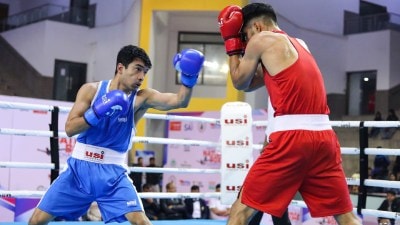Figurative works are most in demand
Pricing a work of art is never an easy job. This is even more true of contemporary art in India, where the studio price, gallery price and a...

Pricing a work of art is never an easy job. This is even more true of contemporary art in India, where the studio price, gallery price and auction price differ considerably. The studio price may be in the region of 30-50 per cent of the gallery price and the auction price may well be double the gallery price.
Take a Gaganendranath Tagore cartoon or drawing. One sold for Rs 1,28,000 at the Southeby8217;s Indian sale in London in May, 1997. While a similar work priced at the HEART auction in November that year failed to achieve the Rs 1,75,000 mark, with the bidding going up to only Rs 1,25,000.
Now a similar work is up for sale at Rs 1,25,000 at the World Wild Life Fund auction on January 24. It is likely to be sold at that reserve price.
Similarly, while the M F Husain Mother Theresa sold for Rs 9,12,000 in 1996 at the Southeby8217;s auction in New York, a larger painting of his famous horses was bid up to Rs 9,25,000, but was bought in at London at the end of that year. At the HEART sale, another horse painting of his went for Rs 3 lakh, so one expects the M F Husain 8212; slated at Rs 6,50,000 8212; to do better at the World Wild Life Fund auction.
Ganesh Pyne drawings also give a good idea of pricing. An ink and wash drawing was priced at Rs 1,27,000 at the Southeby8217;s New York sales of June 1995. By April 1996, a similar work went for Rs 1,69,000 at the Southeby8217;s in New York. At the same time, pen drawings went for between Rs 58,000 to Rs 81,760. At the HEART auction these went for Rs 1.40 lakh to Rs 1.50 lakh. On this basis one can predict that at the World Wild Life Fund auction, the two lots priced at Rs 90,000 and Rs 1.10 lakh should more than top the assessed price.
Another artist whose sale prices can be used to judge the market is Jamini Roy. In 1995, a large Gopini of his fetched Rs 8 lakh, but later in 1997, a similar work fetched Rs 4.08 lakh. At the recent HEART auction, Jamini Roy works appear to have stabilised at around Rs 3-4 lakh. So the assessed prices of his larger works from Rs 1.50 lakh to Rs 3.25 lakh at the World Wild Life Fund auction, appear likely to be surpassed.
From this cursory reading, it is evident that the prices of our contemporary art have stabilised considerably. Prices of works of artists like M F Husain, S H Raza, Nandalal Bose, Abanindranath Tagore, Ram Kinker Baij, Sailoz Mookerjee, Jamini Roy, Bikash Bhattacharya and Ganesh Pyne can be assessed with a fair degree of accuracy, so the buyer need not worry. Here, 30 per cent less for a private sale than a gallery sale and some 50 per cent less for a gallery sale than an auction sales seems to be a reasonable enough assessment.
In fact, the Indian taste does not appear to have changed very much. Figurative works appear most in demand, while oil or tempere on canvas is the preferred medium. In terms of trends, the Bombay group of artists, M F Husain, S H Raza, F N Souza and V S Gaitonde seem to share the centre-stage, with Bengal masters like Nandalal Bose, Benode Bihari Mukherjee, Ramkinker Baij and the Tagores, Rabindranath, Abanindranath and Gaganendranath with Jamini Roy and Ganesh Pyne representing a more folk-oriented approach.
Of late, however, there has been a certain neo-colonial nostalgia which is centred on artists like Ravi Varma, J F Pithawala, M Dhuranshar and Hemen Majumdar, among others. But that too is being overtaken by more innovative and independent realistic artists like Bikash and Sanjay Bhattacharya, and younger ones like Atul Dodiya, Rahul Arya, Madhoor Kapur and Vijinder Sharma. Therefore, the prices of works representing these trends are more reliable and serve as an index of what contemporary art market is.
- 01
- 02
- 03
- 04
- 05































